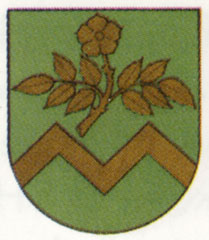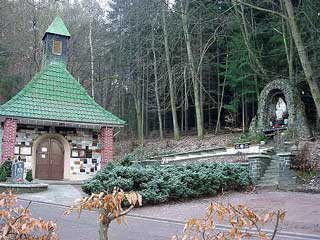Margaretha (Gretchen) Kunz |
Born: 07 May 1868
|
Died: 13 September 1905
|

|
 |
Margaretha, known as Gretchen, was the great-great granddaughter of Peter and Maria Recktenwald. She was the youngest of eight surviving children of Jakob Kunz (1822-1867) and Magdalena Schorr (1827-1890). Jakob worked as a farmer and a miller, and died in a mill accident in Alsweiler five months before Gretchen was born. The coat of arms of Marpingen is shown here.
On 3 July 1876, Gretchen was one of three eight-year-old friends who went to gather bilberries. The other girls were Katharina Hubertus and Susanna Leist. They entered the Härtelwald, a hilly wooded area with rocky gullies that was a few minutes from Marpingen to the southeast.
The bell announcing the time for the Angelus (evening prayers) sounded, and the girls began to head home. While passing through a wild meadow between the woods and the village, Susanna called out, and drew her friends' attention to a white figure. When the girls arrived home, excited and frightened, they said they had seen a woman in white carrying a child in her arms.
The following day, the girls returned to the spot and knelt to pray. After repeating the Lord's Prayer three times, the figure appeared again to Gretchen and Katharina. When asked who she was, the apparition said, "Ich bin die unbefleckt Empfangene" ("I am the Immaculately Conceived"). When asked what they should do, the girls were told to pray, and the figure disappeared.
Over the next few days, the visions continued, and the apparition, now seen as the Virgin Mary, directed that a chapel be built and encouraged the sick to come to her. Others began to claim seeing the Virgin, and miraculous cures were reported.
Within days, Marpingen had become the "German Lourdes." Thousands of pilgrims descended on the village, which had a population of only 1,600. On 13 July, a company from the Prussian army was sent in to clear the site, and many of the pilgrims were wounded by blows from rifle butts and cuts from bayonets. The town was occupied by the military for two weeks. Afterwards, additional gendarmes were stationed in the town and at the apparition site. In August, a decree banned pilgrims from entering the Härtelwald.
The Prussian government's heavy-handed response to the episode is reflective of the Kulturkampf, the struggle between Bismark and the Catholic Church during the 1870s.
In late October and early November, several members of the community were arrested, including the village priest and the priest in Alsweiler. They were interrogated in Saarbrücken to determine their role in the incident.
The girls were repeatedly interrogated by a variety of officials, especially Gretchen, who came to be seen as the ringleader of the girls. In November, following a guardianship court judgment, they were sent to a Protestant-run orphanage in Saarbrücken for nearly five weeks. There followed a series of confessions, and then retractions once the girls returned to Marpingen, with their parents encouraging them to stick to their story.
The apparitions continued for fourteen months, until September 1877. In May 1878, the three girls were sent to the Convent of the Poor Child Jesus in Echternach, Luxemburg. They continued to claim that the apparitions were genuine.
Nineteen individuals were eventually tried by the state in March 1879. Most of them were charged with fraud. All of the defendants were pronounced innocent by the court. The last of the gendarmes stationed in the Härtelwald were withdrawn in November 1879.
The Church also investigated the episode. Even though the village priest and many others were believers, the Church came to the conclusion that the events in Marpingen were inauthentic. However, no official judgment was made public.
Susanna Leist died at age 14 in 1882. Katharina Hubertus took vows in June 1897 with the Order of the Poor Child Jesus, and died in December 1904 in Aachen. She was 36.
Margaretha remained in Echternach until October 1885, when she entered the household of a Father Kreuzer in Münster as a maid. During her Easter 1887 confession, she admitted that she had lied about the apparitions.
In February 1888, she went to the Convent of St. Joseph in Thorn, West Prussia. She worked there as a maid and took the name Maria Althof. In January 1889, she wrote a full confession about what had happened in Marpingen. She claimed that the visions had been "a big lie," and that Susanna Leist's mother played a crucial role in identifying the "woman in white" as the Virgin Mary.
Margaretha returned to Münster, where she entered the order of the Poor Clares and took the name of Sister Maria Stanislaus. Apparently, however, she began once again to claim that the apparitions had occurred, and this led to her dismissal from the Poor Clares. She was then accepted into the Order of the Sisters of Providence, taking the name of Sister Olympia. She spent her last 15 years with this order, and was said to have affirmed the truth of her visions on her death bed. Sister Olympia died at age 37.
 |
The chapel in the Härtelwald, which was built in 1933. It continues to serve as an important site for Marian devotion. [A full account of the events in Marpingen and their aftermath can be found in the book by Blackbourn (1994).] |
| Index | Sources |